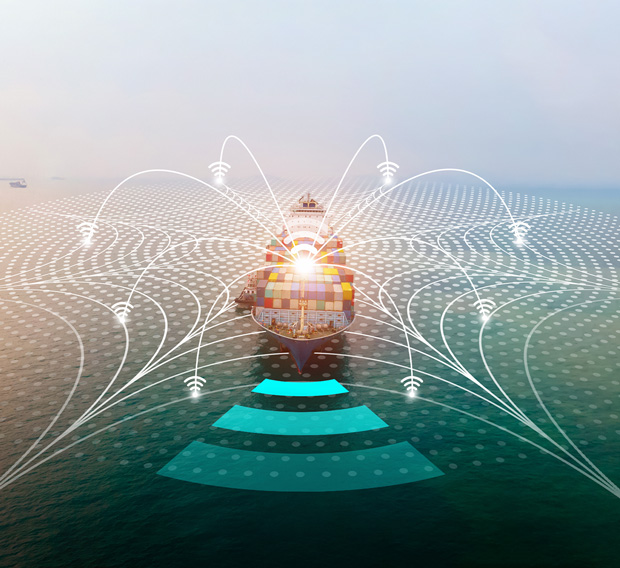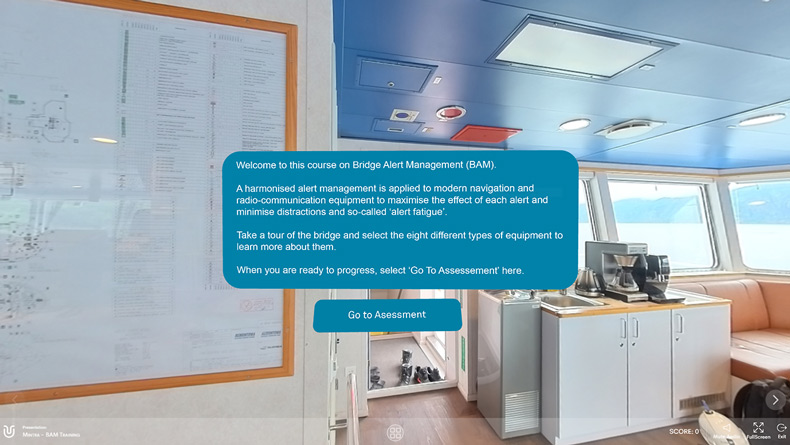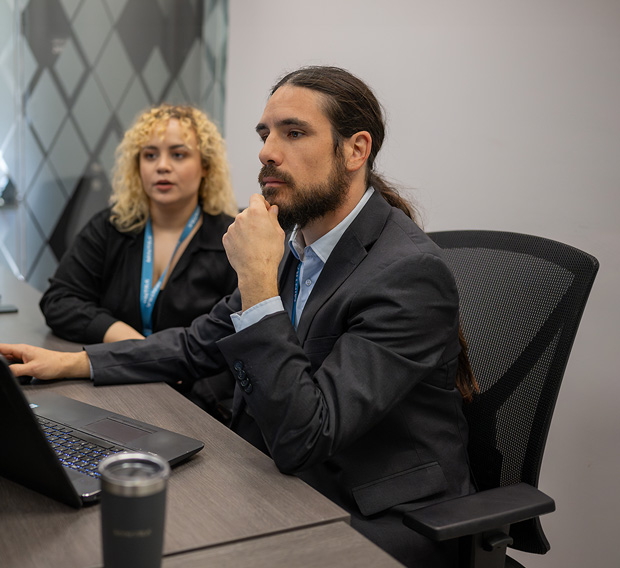Bridging the Competence Gap: Empowering Seafarers with Immersive Training Solutions
AI was the word on everyone’s lips at Smart4Sea Athens this year. From discussions and concerns about its inherent flaws, such as hallucinations and data leaks, to the highly specialised scope of application by experts bridging the implementation gap. It was a lively debate and all keenly embraced by our very own Instructional Designer, Project Manager and Nautical Trainer, Marvin Bielek. Read the highlights of his fascinating presentation on immersive training here.
In the shifting landscape of the maritime industry, the introduction of new regulations and technologies has become a driving force for change. However, this rapid transformation has given rise to a growing concern – the competence gap among seafarers.
How can immersive training solutions, like AI, VR, and cloud simulations, help our global crews bridge the competence gap and navigate future challenges?

Marvin Bielek, Project Manager & Instructional Designer800,000 seafarers may require additional training by the mid-2030s to operate vessels running on zero or near-zero emission fuels. "
The Impact of Regulatory Changes
Regulatory changes, like the recent implementation of the emission trading system (ETS) by the European Union and the International Maritime Organization's (IMO) regulations on EEXI and CII, drive the need for innovative solutions in ship performance and the adoption of green technologies. As the industry transitions to alternative fuels, such as LNG, LPG, methanol, ammonia, hydrogen, and even nuclear power, seafarers are faced with the challenge of acquiring new knowledge and skills to operate these technologies efficiently and remain fully competent in their field. Recent research commissioned by the Maritime Just Transition Task Force highlighted that 800,000 seafarers may require additional training by the mid-2030s to operate vessels running on zero or near-zero emission fuels.
The evolution of fuel and the transition of technology are happening before our eyes. According to DNV “In mid-2022, a third of tonnage on order could use LNG, LPG or methanol in dual-fuel engines. By mid-2023, that had risen to half.” Today, by tonnage, 6.5% of ships operating can run on alternative fuels, compared with 5.5% last year. It’s encouraging, but 6.5% is still too small a number to make a significant impact and retrofitting existing vessels is rarely an option. This emphasises the importance of finding alternative ways to improve fuel efficiency, especially as shipping competes with other industries and infrastructure and availability become an increasing challenge.


Technological Advancements in the Maritime Sector
Beyond environmental concerns, technological advancements have transformed various aspects of the maritime sector. One example of such a transformation is underwater inspections, traditionally performed by divers, but now advanced to involve remotely operated vehicles (ROVs) operated by seafarers, requiring them to adapt to new responsibilities.
Another example might be the additional skills required for seafarers to master the integration of big data and real-time analytics through advanced monitoring or integrated bridge systems on newer vessels.
External factors, such as vetting, flag or port state regulations, and specific charterer requirements, undoubtedly improve the safety of shipping but also contribute to the complexity of the seafarers' learning experience. With the variability in ship assignments, mastering these intricate details becomes a significant challenge.
In other areas, technology has superseded regulation and left little time for essential training to catch up. For example, the complex upcoming changes in ECDIS rely heavily on the navigator’s ability to interpret and configure what they see efficiently. This would be an ideal scenario for proactive and dynamic immersive learning, yet mandatory training regulations are lagging behind.
Immersive Training Solutions: A Way Forward
In response to the competence gap, the maritime industry is turning to immersive training solutions. Augmented Reality (AR), Virtual Reality (VR), simulators, digital learning, microlearning, and AI are emerging as powerful tools for seafarer education.
AR is being widely adopted, with 63% of companies using it to enhance learning and extending it to provide on-the-job support as well.
However, the presence of these technologies does not automatically close the competence gap. What we must first overcome is the implementation gap, characterised by a lack of expertise in designing adequate training content for such a diverse and distributed workforce, whilst embracing a vast range of topics.
Simulator training is one area that has an implementation gap having faced many hurdles in the transition from traditional physical simulators in educational institutes to cloud-based platforms in the post-pandemic climate. Many of the original educational institutes that offered specialist simulator courses in full-engine or bridge simulators closed when travel was restricted, losing their classroom-based business overnight. Other training businesses began diversifying and using cloud simulators, but they didn’t have the tailored training content and specialist exercises the institutes had.
VR, is another area facing implementation challenges. It is increasing in popularity and its interactive and authentic learning potential is undoubtedly valuable to maritime training.
Yet, just incorporating VR into any course is not going to solve the competence gap. It is crucial that content is designed from the ground up with the focus on learning outcomes. Courses such as SOPEP and enclosed space entry may well benefit from the immersive experience, whereas some courses such as mental health or maritime leadership may well not. Custom learning content and interactive assessments tailored to the strengths of VR are the only way to ensure effective training.


The Bridge Alert Management Course soon to be launched on Mintra Trainingportal uses 360-degree photography to enable the learner to experience walking around on the bridge whilst combining information, like categories, priorities and types of alerts, with becoming spatially aware of the physical locations on the bridge – an ideal experience for VR.
The key point in its development, however, is that it is not just an existing course with an additional layer for VR usage. The design process focused on a full-scale analysis of the topic with its relevant learning outcomes on the one side and the different tools and learning solutions with all their strengths and limitations on the other hand. The conclusion was that this specific topic can fully profit from the 360-degree media and the VR experience, resulting in the course being wholly designed with that in mind, making the best possible use of the interactivity that walking around on a bridge provides.
Conclusion
The competence gap in the maritime industry is a challenge that can be effectively addressed through the judicious use of immersive training solutions. By aligning the right technology.
with specific learning content and designing courses that capitalise on the strengths of these technologies, we can empower seafarers to navigate the complexities of the maritime sector confidently.
As we invest time in impactful training, we contribute to a safer and more resilient shipping industry. The journey to bridge the competence gap is underway, and the future looks promising.
Written by Marvin Bielek, Instructional Designer, Project Manager and Nautical Trainer at Mintra. Following a career as a nautical officer Marvin developed a passion for navigational safety and how modern technology can be leveraged to serve navigation officers and keep vessels safe, from bridge layout and software interfaces to the design of training practices. Today, he is Mintra’s expert on ECDIS training and learning design for safety critical industries.
To find out more about immersive learning for your team, contact info@mintra.com.

Insights & News
At Mintra, we're so much more than just a team—we're a force driving innovation and excellence in maritime training across Europe.
We’re excited to be taking the stage at one of Europe’s leading showcases of organisational learning.
We are delighted to share the exciting news that our People and Culture team has been shortlisted for the prestigious cHeRries Awards!